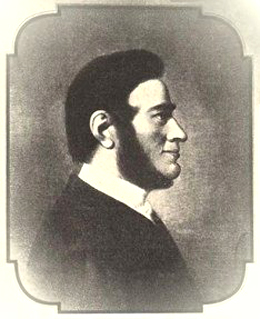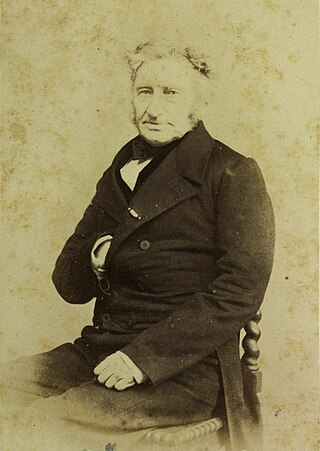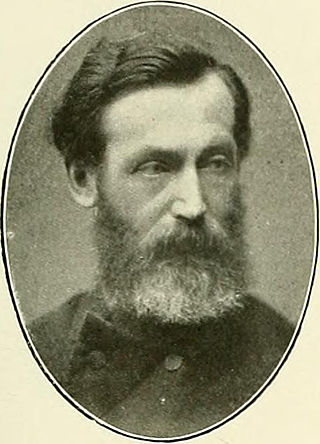
Philipp Wilhelm Wirtgen (4 December 1806 – 7 September 1870) was a German botanist and teacher born in Neuwied, Germany. He was the father of botanist Ferdinand Paul Wirtgen (1848–1924).

Philipp Wilhelm Wirtgen (4 December 1806 – 7 September 1870) was a German botanist and teacher born in Neuwied, Germany. He was the father of botanist Ferdinand Paul Wirtgen (1848–1924).
He was a school teacher in Remagen, Winningen and beginning in 1831, at Koblenz, where from 1835 to 1870, he served as an instructor at the Evangelischen Höheren Stadtschule. [1] With botanist Theodor Friedrich Ludwig Nees von Esenbeck (1787-1837), he was founder of the Botanischer Verein am Mittel- und Niederrhein (Botanical Association of the Middle and Lower Rhine).
Wirtgen specialized in the study of Rhineland flora, and his work largely dealt with phytogeography, taxonomy and floristics within the field of botany. Among his numerous publications was an 1857 book involving flora native to Rhine Province called "Flora der preußischen Rheinprovinz und der zunächst angränzenden Gegenden", and a treatise titled "Neuwied und seine Umgebung" (Neuwied and its Environment). Other noted works by Wirtgen include:
He published several exsiccatae, the first starting around 1842 with Michael Bach and among others the series Herbarium plantarum criticarum, selectarum, hybridarumque florae Rhenanae. [3]
The plant genus Wirtgenia (family Asteraceae) was named in his honor by Carl Heinrich "Bipontinus" Schultz (1842). [1] [4]

Carl Friedrich Philipp von Martius was a German botanist and explorer. Between 1817 and 1820, he travelled 10,000 km through Brazil while collecting botanical specimens. His most important work was a comprehensive flora of Brazil, Flora Brasiliensis, which he initiated in 1840 and was completed posthumously in 1906.

Carl Borivoj Presl was a Czech botanist.

Heinrich Gottlieb Ludwig Reichenbach was a German botanist, ornithologist and illustrator. It was he who first requested Leopold Blaschka to make a set of glass marine invertebrate models for scientific education and museum showcasing, the successful commission giving rise to the creation of the Blaschkas' Glass sea creatures and, subsequently and indirectly, the more famous Glass Flowers.
Christian Friedrich Ecklon was a Danish botanical collector and apothecary. Ecklon is especially known for being an avid collector and researcher of plants in South Africa.
Michael Bach was a German entomologist specialising in Coleoptera and a botanist. He was a teacher in Boppard and a Member of the Entomological Society of Stettin.

David Heinrich Hoppe was a German pharmacist, botanist, entomologist and physician. He is remembered for contributions made to the study of alpine flora.
Christian Friedrich Heinrich Wimmer was a German botanist and educator who was a native of Breslau.

Ferdinand Christian Gustav Arnold was a German lichenologist and taxonomist born in Ansbach, Bavaria. Even as a high school student he showed an active interest in botany: "Ich und August Gattinger ... durchstreiften von November 1846 bis zum Spätherbst 1847, Pflanzen sammelnd, die Landschaft von München nach allen Richtungen.".

Georg Hans Emmo Wolfgang Hieronymus (1846–1921) was a European botanist of German extraction. He was born in Silesia and died in Berlin.
Yury Nikolaevitch Voronov was a Russian botanist. He worked at the Botanical Garden in Leningrad.

Heinrich Moritz Willkomm was a German botanist who served as a professor of botany at Tharandt, the University of Dorpat and at the University of Prague. He travelled widely across Spain and Portugal and became a specialist on the flora of the Iberian region. The standard author abbreviation Willk. is used to indicate this person as the author when citing a botanical name.

Philipp (Filip) Maximilian Opiz was a Czech-German forester and botanist.

Hans Höppner was a German botanist and entomologist.
Chrétien Géofroy Nestler, name also given as Christian Gottfried Nestler, was a botanist and pharmacist from Alsace.
Ferdinand Paul Wirtgen was a German pharmacist and botanist. He was the son of botanist Philipp Wilhelm Wirtgen (1806–1870).
Heinrich Andres was a German educator and botanist known for his investigations of Rhineland flora.

Harald Lindberg was a Finnish botanist of Swedish parentage. He was the son of botanist Sextus Otto Lindberg (1835–1889).
Adriano Fiori was an Italian botanist.

Johan Petter Norrlin was a Finnish botanist and a professor of botany at the University of Helsinki from 1879 to 1903. He was a pioneer of plant geography in Finland, and is also well known for his work on lichens and on the taxonomy of the apomictic taxa of the plant genera Hieracium and Pilosella.

Exsiccata is a work with "published, uniform, numbered set[s] of preserved specimens distributed with printed labels". Typically, exsiccatae are numbered collections of dried herbarium specimens or preserved biological samples published in several duplicate sets with a common theme or title, such as Lichenes Helvetici. Exsiccatae are regarded as scientific contributions of the editor(s) with characteristics from the library world and features from the herbarium world. Exsiccatae works represent a special method of scholarly communication. The text in the printed matters/published booklets is basically a list of labels (schedae) with information on each single numbered exsiccatal unit. Extensions of the concept occur.